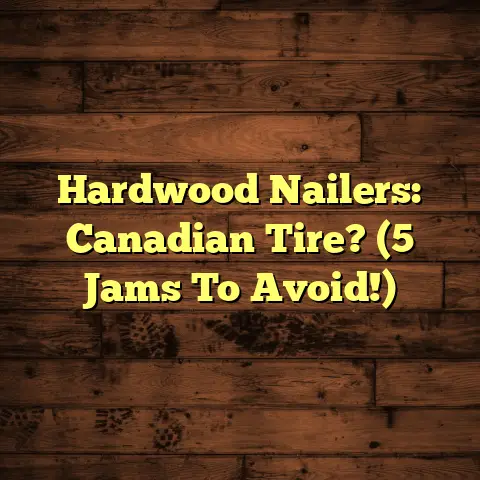Sustainable Flooring: Best Choices? (1 Green Pick)
Imagine your home as a garden. The flooring? It’s the soil. The foundation for everything else. Just like you’d choose nutrient-rich soil for healthy plants, selecting the right flooring sets the stage for a healthy, vibrant living space.
I’ve seen trends come and go, but one thing that’s here to stay is the growing demand for sustainable flooring.More and more of you are realizing that what you put under your feet matters – not just for comfort and style, but for the planet too.
So, what exactly is sustainable flooring? It’s all about making choices that minimize environmental impact, from the sourcing of materials to the manufacturing process and even disposal.
This article is your guide to navigating the world of eco-friendly flooring. We’ll explore different options, weigh their pros and cons, and I’ll even reveal my top “Green Pick” – the one I wholeheartedly recommend for my clients who want to make a real difference. Get ready to dive in!
2. Understanding Sustainability in Flooring
Okay, let’s get down to brass tacks. What does “sustainability” really mean when we’re talking about flooring?
In a nutshell, it means choosing materials and practices that:
- Minimize environmental impact: This includes reducing carbon emissions, conserving resources, and avoiding pollution.
- Are renewable or recycled: Think materials that can be replenished quickly or repurposed from existing sources.
- Promote healthy indoor air quality: Low-VOC (volatile organic compound) materials are key here.
- Are durable and long-lasting: This reduces the need for frequent replacements, saving resources in the long run.
The Dark Side of Traditional Flooring
Now, let’s talk about the elephant in the room: traditional flooring options. Hardwood, laminate, and vinyl can have some serious environmental baggage.
- Hardwood: Deforestation is a major concern, especially when wood is sourced from unsustainable forests. The transportation of lumber also adds to the carbon footprint.
- Laminate: Often contains formaldehyde, a known carcinogen, and isn’t always recyclable.
- Vinyl: Made from PVC (polyvinyl chloride), a petroleum-based plastic. The production process releases harmful toxins, and it’s difficult to recycle.
According to the EPA, Americans discarded more than 10 million tons of carpet and rugs in 2018 alone. (Source: EPA Sustainable Materials Management Fact Sheet) That’s a lot of waste ending up in landfills.
Key Concepts: LCA, Carbon Footprint, and Renewable Resources
To truly understand sustainable flooring, you need to know these terms:
- Lifecycle Analysis (LCA): This assesses the environmental impact of a product throughout its entire lifecycle, from raw material extraction to manufacturing, transportation, use, and disposal.
- Carbon Footprint: The total amount of greenhouse gases generated by a product or activity. Lower is better!
- Renewable Resources: Materials that can be replenished naturally within a reasonable timeframe, like bamboo or cork.
Choosing flooring with a low LCA, small carbon footprint, and made from renewable resources is the name of the game.
The Benefits of Going Green
Why bother with sustainable flooring? Here’s why:
- Reduced Environmental Impact: You’re helping to conserve resources, reduce pollution, and combat climate change.
- Improved Indoor Air Quality: Low-VOC materials create a healthier living environment for you and your family.
- Long-Term Cost Savings: Durable, sustainable flooring can last for decades, reducing the need for replacements.
- Increased Home Value: Eco-friendly features are becoming increasingly desirable to homebuyers.
A study by the World Green Building Council found that green buildings can command a price premium of up to 12% compared to conventional buildings. (Source: World Green Building Council)
3. Exploring Sustainable Flooring Options
Alright, let’s get to the fun part: exploring the different types of sustainable flooring available. I’m going to break it down for you.
3.1 Bamboo Flooring
Characteristics, Benefits, and Drawbacks:
Bamboo flooring is made from bamboo grass, a highly renewable resource that grows incredibly fast.
Pros:
- Renewable: Bamboo can be harvested every 3-5 years without killing the plant.
- Durable: Strand-woven bamboo is even harder than some hardwoods.
- Stylish: Offers a unique, modern look.
- Relatively Affordable: Often less expensive than hardwood.
Cons:
- Vulnerable to Scratches: Softer than some hardwoods.
- Moisture Sensitive: Can warp or swell in humid environments.
- Formaldehyde Concerns: Some bamboo flooring contains formaldehyde in the adhesives. Always look for low-VOC options.
Environmental Impact and Sustainability Credentials:
Bamboo’s rapid growth makes it a highly sustainable material. However, it’s often grown and manufactured in Asia, so transportation can contribute to its carbon footprint.
Look for bamboo flooring that’s certified by the Forest Stewardship Council (FSC) or the Bamboo Inspection Bureau (BIB).
3.2 Cork Flooring
Properties and Advantages:
Cork flooring is made from the bark of the cork oak tree, which regenerates after harvesting. It’s naturally cushioned, warm, and quiet underfoot.
Pros:
- Renewable: The bark can be harvested every 9-12 years without harming the tree.
- Comfortable: Provides excellent cushioning and sound insulation.
- Naturally Antimicrobial: Resists mold and mildew growth.
- Warm: Feels warmer than tile or stone.
Cons:
- Prone to Dents: Can be damaged by heavy furniture or sharp objects.
- Moisture Sensitive: Needs to be properly sealed to prevent water damage.
- Limited Style Options: The natural look of cork may not appeal to everyone.
Renewal Process and Ecological Benefits:
The cork oak forests of Portugal and Spain are vital ecosystems that support a rich biodiversity. Harvesting cork actually benefits the trees, encouraging growth and extending their lifespan.
Cork oak forests also play a crucial role in carbon sequestration, absorbing and storing large amounts of carbon dioxide from the atmosphere.
3.3 Reclaimed Wood Flooring
Definition and Sourcing:
Reclaimed wood flooring is made from wood that has been salvaged from old buildings, barns, and other structures. It’s a great way to give new life to materials that would otherwise end up in landfills.
Pros:
- Sustainable: Reduces the demand for new wood and prevents waste.
- Unique Aesthetics: Offers a rustic, character-rich look with historical charm.
- Durable: Often made from old-growth wood, which is denser and more resistant to wear and tear.
Cons:
- Can Be Expensive: Sourcing and processing reclaimed wood can be labor-intensive.
- Limited Availability: The supply of reclaimed wood is finite.
- Potential for Lead Paint: Older reclaimed wood may contain lead paint, so proper testing and sealing are essential.
Unique Aesthetics and Sustainability:
Reclaimed wood flooring tells a story. Each plank has its own unique history, with nail holes, knots, and other imperfections that add character and charm.
By choosing reclaimed wood, you’re not only reducing waste but also preserving a piece of history.
3.4 Linoleum Flooring
Composition and Eco-Friendliness:
Linoleum is made from natural, renewable materials like linseed oil, rosin, cork dust, wood flour, and mineral pigments. It’s a surprisingly eco-friendly option that’s been around for over a century.
Pros:
- Renewable: Made from mostly renewable resources.
- Durable: Can last for decades with proper care.
- Naturally Antibacterial: Inhibits the growth of bacteria and germs.
- Low-VOC: Doesn’t emit harmful chemicals.
- Water Resistant: Suitable for kitchens and bathrooms.
Cons:
- Can Be Brittle: Can crack or chip if not properly installed or maintained.
- Requires Sealing: Needs to be sealed to protect against stains and moisture.
- Limited Design Options: The color and pattern choices are not as extensive as with other flooring materials.
Durability and Maintenance Considerations:
Linoleum is a tough and resilient flooring option that can withstand heavy foot traffic. Regular sweeping and mopping are all that’s needed to keep it looking its best.
3.5 Carpet Tiles
Versatility and Recycling Potential:
Carpet tiles are a modular flooring option that’s easy to install and replace. They’re a great choice for basements, offices, and other high-traffic areas.
Pros:
- Easy to Install: Can be installed DIY with minimal tools.
- Replaceable: Damaged tiles can be easily replaced without having to replace the entire floor.
- Versatile: Available in a wide range of colors, patterns, and textures.
- Recycling Potential: Some manufacturers offer take-back programs for recycling old carpet tiles.
Cons:
- Seams Can Be Visible: The seams between tiles may be noticeable.
- Can Be Expensive: High-quality carpet tiles can be pricey.
- Potential for Off-Gassing: Some carpet tiles may contain VOCs in the adhesives or backing.
Impact on Indoor Air Quality:
Choose carpet tiles with low-VOC adhesives and backings to minimize their impact on indoor air quality. Look for certifications like Green Label Plus from the Carpet and Rug Institute (CRI).
4. In-Depth Focus on the Green Pick: Cork Flooring
Okay, after all that, I’m ready to reveal my “Green Pick” for sustainable flooring: Cork Flooring.
Why cork? Let me tell you. I’ve installed it in countless homes, and I’m consistently impressed by its performance, sustainability, and overall value.
Origin and Production
Cork flooring comes from the bark of the cork oak tree (Quercus suber), primarily found in Portugal and Spain. What’s amazing is that the bark can be harvested every 9-12 years without killing the tree. Skilled workers use axes to carefully strip the bark, a process that requires years of training and expertise.
After harvesting, the cork bark is boiled, dried, and processed into various products, including flooring. The manufacturing process is relatively low-impact, using minimal energy and water.
Environmental Benefits
Cork flooring is a sustainability superstar for several reasons:
- Renewable Resource: As I’ve mentioned, the bark regenerates after harvesting, making cork a truly renewable material.
- Carbon Sequestration: Cork oak forests are excellent carbon sinks, absorbing and storing large amounts of CO2. In fact, harvested cork oaks absorb three to five times more CO2 than unharvested trees.
- Biodiversity: Cork oak forests support a rich biodiversity, providing habitat for endangered species like the Iberian lynx and the Iberian imperial eagle.
- Waste Reduction: Cork waste from the wine stopper industry is often recycled into flooring and other products.
- Low-VOC: Cork flooring is naturally low in VOCs, contributing to healthy indoor air quality.
Aesthetic Appeal
Cork flooring isn’t just eco-friendly; it’s also beautiful. It comes in a variety of colors, patterns, and textures, from natural, earthy tones to bold, modern designs.
It can complement a wide range of interior styles, from rustic farmhouse to sleek contemporary. Plus, its natural warmth and texture add a touch of coziness to any space.
Cost Analysis
Cork flooring is generally mid-range in terms of cost, falling somewhere between laminate and hardwood. The initial investment may be higher than some other options, but the long-term benefits are well worth it.
Here’s a breakdown of the costs:
- Material Costs: $3 to $8 per square foot, depending on the quality and style of the flooring.
- Installation Costs: $2 to $5 per square foot, if you hire a professional.
- Long-Term Savings: Cork flooring is durable and long-lasting, reducing the need for replacements. Its natural insulation properties can also lower your energy bills.
Installation and Maintenance
Cork flooring can be installed as either tiles or planks, using either a glue-down or click-lock system. DIY installation is possible, but I recommend hiring a professional for best results.
Maintenance is relatively simple:
- Sweep or vacuum regularly: To remove dirt and debris.
- Mop with a damp cloth: Use a mild detergent specifically designed for cork flooring.
- Re-seal periodically: To protect against stains and moisture.
Consumer Testimonials
Don’t just take my word for it. Here are a few quotes from my clients who have chosen cork flooring:
- “I love how soft and warm the cork feels under my feet. It’s so much more comfortable than the tile we had before.” – Sarah, Homeowner
- “We chose cork flooring for our yoga studio because it’s naturally antimicrobial and provides excellent sound insulation. Our clients love it!” – Mark, Yoga Studio Owner
- “As a green builder, I’m always looking for sustainable materials. Cork flooring is one of my go-to choices because it’s eco-friendly, durable, and beautiful.” – David, Green Builder
5. Conclusion
We’ve covered a lot of ground in this article, from understanding the importance of sustainability in flooring to exploring various eco-friendly options. We’ve seen that bamboo, reclaimed wood, linoleum, and carpet tiles all have their merits, but my top pick remains cork flooring.
Choosing sustainable flooring is more than just a trend; it’s a responsibility. By making informed decisions about the materials we use in our homes, we can reduce our environmental impact and create healthier living spaces for ourselves and future generations.
Remember that opening metaphor about your home being a garden and your flooring being the soil? Just like choosing the right soil is crucial for a thriving garden, selecting sustainable flooring is essential for a healthy and vibrant home.
So, the next time you’re considering new flooring, I encourage you to think green. Choose materials that are renewable, recycled, and low-VOC. Make a conscious decision to protect our planet, one step at a time. Your feet – and the Earth – will thank you for it.





